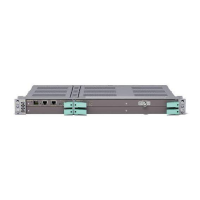Radio Terminals
9970
f
1
, V
A
Near end Node Far end Node
MMU2
F 155
Active
Active
Active
f
2
, V
B
f
1
, H
A
Active
f
2
, H
B
XPIC cross-cables
MMU2
F 155
MMU2
F 155
MMU2
F 155
MMU2
F 155
MMU2
F 155
MMU2
F 155
MMU2
F 155
Figure 79 1+1 XPIC in W orking Standby
In both schemes the V (H) polarized branch labeled B protects the V (H)
polarized branch labeled A, and vice versa if revertive mode is disabled and
after repairing the fault.
In 1+1 XPIC configuration the switching criteria are exactly the same criteria
used in 1+1 protected configuration with single polarization mode and the two
switching processes for H and V branches are independent.
When a fault occurs on one polarization, e.g. V, and the switching criteria
are satisfied, the switching to the protection link is initiated, from V
A
to V
B
.If
the fault does not cause a high degradation of the cancelling signal on the
orthogonal polarization (switching criteria for H polarization are not satisfied),
the switching to the protection link, from H
A
to H
B
, is not initiated.
If the depolarization is such that the H-polarization canceller is not able to
cancel the cross-polar interference from H (switching criteria for H-polarization
are satisfied), the switching to the protection link, from H
A
to H
B
, is initiated.
A HW fault, for example on the V link, might cause a simultaneous degradation
of the two polarizations, triggering a switch on both V and H link. Table 1 on
page 90 summarizes the consequent actions to a fault on V-polarization link.
89
4/1555-CSH 109 32/1-V1 Uen B 2007-09-14

